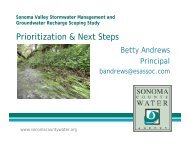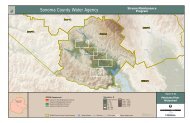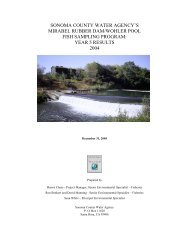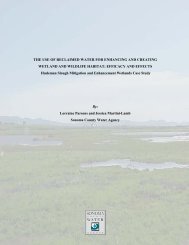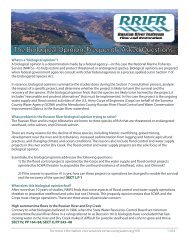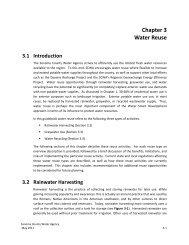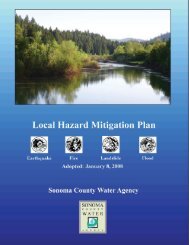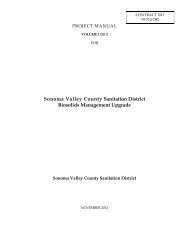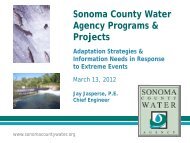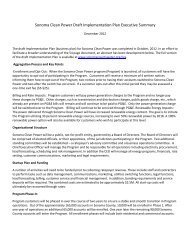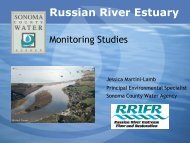Hydrography of the Russian River Estuary - Sonoma County Water ...
Hydrography of the Russian River Estuary - Sonoma County Water ...
Hydrography of the Russian River Estuary - Sonoma County Water ...
You also want an ePaper? Increase the reach of your titles
YUMPU automatically turns print PDFs into web optimized ePapers that Google loves.
unaffected and remains resident for at least a month (<strong>the</strong> period <strong>of</strong> closure). Indeed,<br />
some deeper waters remain trapped and resident for days after <strong>the</strong> 5 October<br />
breaching.<br />
<strong>Water</strong> column conditions and thus habitat value in <strong>the</strong> closed estuary are largely<br />
controlled by stratification. This study has identified several key factors:<br />
• The importance <strong>of</strong> processes controlling <strong>the</strong> amount <strong>of</strong> salt contained in <strong>the</strong> estuary<br />
at <strong>the</strong> time <strong>of</strong> closure – and thus <strong>the</strong> subtle importance <strong>of</strong> exactly how and when <strong>the</strong><br />
mouth closes relative to high-low and spring-neap tidal cycles and river flow<br />
variation.<br />
• The importance <strong>of</strong> periods when <strong>the</strong> mouth is semi-closed, allowing outflow but<br />
precluding significant inflow <strong>of</strong> new seawater. The outflowing surface water removes<br />
intermediate density water from above <strong>the</strong> central pycnocline, thus sharpening <strong>the</strong><br />
vertical density gradient and increasing vertical stability.<br />
• The importance <strong>of</strong> wave overwash events at <strong>the</strong> time <strong>of</strong> closure or after closure as<br />
<strong>the</strong>y inject undiluted seawater into <strong>the</strong> estuary with no subsequent outflow. These<br />
events increase <strong>the</strong> total mass <strong>of</strong> salt and <strong>the</strong> overall stability <strong>of</strong> <strong>the</strong> stratification.<br />
• The importance <strong>of</strong> <strong>the</strong> diurnal sea breeze in generating a seiche in <strong>the</strong> estuary with<br />
currents strong enough to slowly mix salt vertically and re-distribute it horizontally<br />
(including possible control <strong>of</strong> intrusion <strong>of</strong> saline waters into <strong>the</strong> inner estuary). In<br />
addition, <strong>the</strong> surface wind stress may have a direct impact on mixing near <strong>the</strong> mouth.<br />
• The importance <strong>of</strong> small variations in river water through-flow and water depths in<br />
precluding or allowing intrusion <strong>of</strong> saline waters over shoals in <strong>the</strong> inner estuary.<br />
• The importance <strong>of</strong> light and <strong>the</strong>rmal radiation that penetrates into <strong>the</strong> stable<br />
pycnocline, resulting in increased dissolved oxygen and increased temperature in<br />
mid-depth layers that are precluded from mixing with ei<strong>the</strong>r deeper or shallower<br />
waters in <strong>the</strong> estuary.<br />
The data described here and in <strong>the</strong> companion data report (Behrens & Largier 2010)<br />
provide a clear view <strong>of</strong> circulation and stratification in <strong>the</strong> <strong>Russian</strong> <strong>River</strong> estuary during a<br />
low-flow summer/fall. Future work should be directed at two suites <strong>of</strong> questions – those<br />
relating to how stratification during closure relates to <strong>the</strong> extent and value <strong>of</strong> water<br />
column habitat for juvenile steelhead (as posed by NMFS 2008), and those relating to<br />
<strong>the</strong> processes that control stratification and mixing in <strong>the</strong> estuary (with a view to<br />
understanding how humans do or can influence <strong>the</strong> outcome). Specifically, <strong>the</strong> following<br />
topics are <strong>of</strong> primary concern:<br />
1. Juvenile salmon habitat. Based on known affinity for given salinity, temperature and<br />
dissolved oxygen values, our knowledge <strong>of</strong> <strong>the</strong> distribution <strong>of</strong> <strong>the</strong>se parameters may<br />
be converted to quantitative knowledge <strong>of</strong> <strong>the</strong> spatial extent <strong>of</strong> primary, marginal and<br />
undesirable water column habitat. Improvements to existing information would come<br />
68




